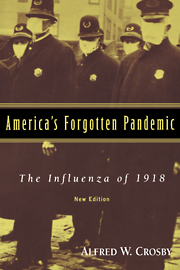Book contents
- Frontmatter
- Contents
- List of Graphs and Tables
- Preface to the New Edition
- PART I An Abrupt Introduction to Spanish Influenza
- PART II Spanish Influenza: The First Wave—Spring and Summer, 1918
- PART III The Second and Third Waves
- PART IV Measurements, Research, Conclusions, and Confusions
- 11 Statistics, Definitions, and Speculation
- 12 Samoa and Alaska
- 13 Research, Frustration, and the Isolation of the Virus
- 14 Where Did the Flu of 1918 Go?
- PART V Afterword
- Index
13 - Research, Frustration, and the Isolation of the Virus
Published online by Cambridge University Press: 05 June 2012
- Frontmatter
- Contents
- List of Graphs and Tables
- Preface to the New Edition
- PART I An Abrupt Introduction to Spanish Influenza
- PART II Spanish Influenza: The First Wave—Spring and Summer, 1918
- PART III The Second and Third Waves
- PART IV Measurements, Research, Conclusions, and Confusions
- 11 Statistics, Definitions, and Speculation
- 12 Samoa and Alaska
- 13 Research, Frustration, and the Isolation of the Virus
- 14 Where Did the Flu of 1918 Go?
- PART V Afterword
- Index
Summary
?Flu?
If we but knew
The cause of flu
And whence it comes and what to do,
I think that you
And we folks, too,
Would hardly get in such a stew.
Do you?
Illinois Health News, vol. 9 (November 1918), p. 203.At the end of World War I, it was apparent to all that the problems of human pathology pressing hardest for solution were war and influenza. Statesmen and diplomats went to Paris to work on the first. Physicians, epidemiologists, and bacteriologists all over the world were already working on the second as the shooting stopped on the Western Front. Coincidentally, in 1933 Hitler became Chancellor of Germany, signalizing the failure of the first group, and Smith, Andrewes, and Laidlaw isolated the virus of influenza, signalizing the relative success of the second.
As of 1918, massive government bankrolling of projects in the life sciences was still far in the future, but there was probably more money, public and private, available for research on influenza and certainly a greater number of skilled scientists of all nations eager to undertake such work than for any similar project before in history. Within one decade of the pandemic of Spanish influenza, scientists published over 4,000 books and articles on flu.
In 1918 there seemed to be an infinity of questions, all of them basic, and hardly any answers at all. What exactly was the difference between the common cold and influenza? Was Spanish influenza the same disease as other pandemic influenzas? Was Spanish influenza, as contrasted with other influenzas, the product of secondary infection?
- Type
- Chapter
- Information
- America's Forgotten PandemicThe Influenza of 1918, pp. 268 - 298Publisher: Cambridge University PressPrint publication year: 2003



